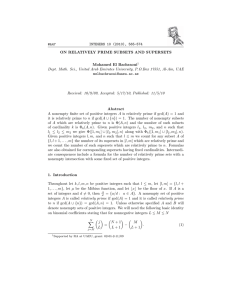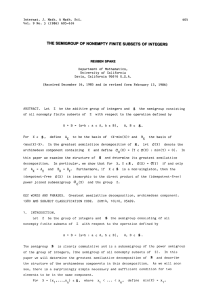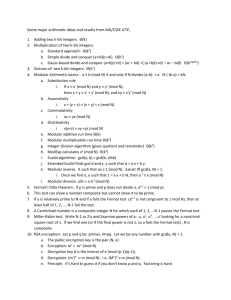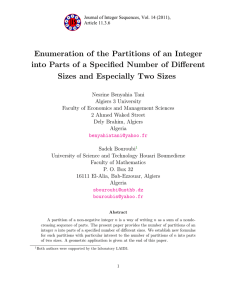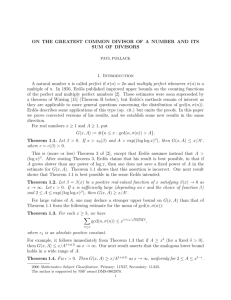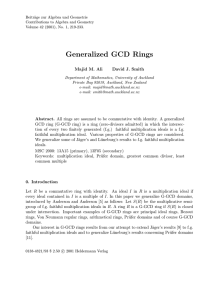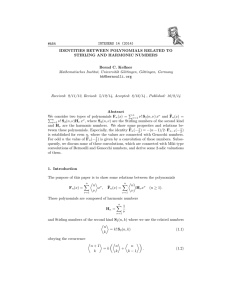INTEGERS 9 (2009), 441-457 #A35 LUCAS DIOPHANTINE TRIPLES Florian Luca
advertisement
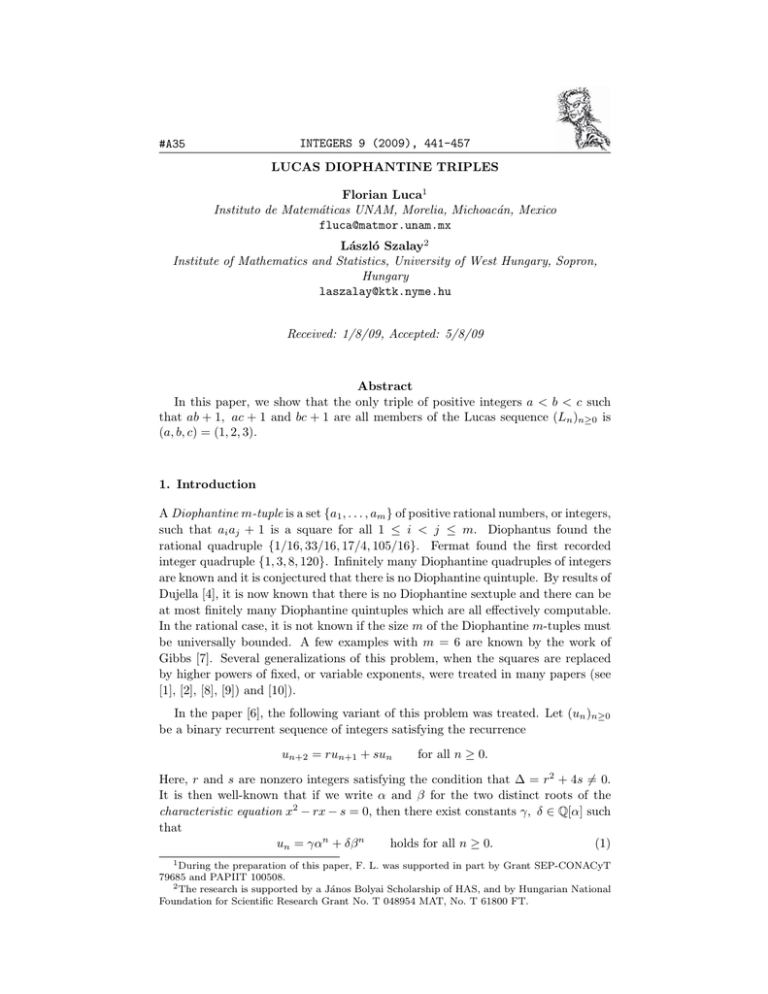
INTEGERS 9 (2009), 441-457
#A35
LUCAS DIOPHANTINE TRIPLES
Florian Luca1
Instituto de Matemáticas UNAM, Morelia, Michoacán, Mexico
fluca@matmor.unam.mx
László Szalay2
Institute of Mathematics and Statistics, University of West Hungary, Sopron,
Hungary
laszalay@ktk.nyme.hu
Received: 1/8/09, Accepted: 5/8/09
Abstract
In this paper, we show that the only triple of positive integers a < b < c such
that ab + 1, ac + 1 and bc + 1 are all members of the Lucas sequence (Ln )n≥0 is
(a, b, c) = (1, 2, 3).
1. Introduction
A Diophantine m-tuple is a set {a1 , . . . , am } of positive rational numbers, or integers,
such that ai aj + 1 is a square for all 1 ≤ i < j ≤ m. Diophantus found the
rational quadruple {1/16, 33/16, 17/4, 105/16}. Fermat found the first recorded
integer quadruple {1, 3, 8, 120}. Infinitely many Diophantine quadruples of integers
are known and it is conjectured that there is no Diophantine quintuple. By results of
Dujella [4], it is now known that there is no Diophantine sextuple and there can be
at most finitely many Diophantine quintuples which are all effectively computable.
In the rational case, it is not known if the size m of the Diophantine m-tuples must
be universally bounded. A few examples with m = 6 are known by the work of
Gibbs [7]. Several generalizations of this problem, when the squares are replaced
by higher powers of fixed, or variable exponents, were treated in many papers (see
[1], [2], [8], [9]) and [10]).
In the paper [6], the following variant of this problem was treated. Let (un )n≥0
be a binary recurrent sequence of integers satisfying the recurrence
un+2 = run+1 + sun
for all n ≥ 0.
Here, r and s are nonzero integers satisfying the condition that ∆ = r2 + 4s #= 0.
It is then well-known that if we write α and β for the two distinct roots of the
characteristic equation x2 − rx − s = 0, then there exist constants γ, δ ∈ Q[α] such
that
un = γαn + δβ n
holds for all n ≥ 0.
(1)
1 During the preparation of this paper, F. L. was supported in part by Grant SEP-CONACyT
79685 and PAPIIT 100508.
2 The research is supported by a János Bolyai Scholarship of HAS, and by Hungarian National
Foundation for Scientific Research Grant No. T 048954 MAT, No. T 61800 FT.
442
INTEGERS: 9 (2009)
Assume further that the sequence (un )n≥0 is nondegenerate in the sense that γδ #= 0
and α/β is not root of unity. Say that the positive integers a < b < c form a
Diophantine triple with values in the set U = {un : n ≥ 0} if ab + 1, ac + 1 and
bc + 1 are all three in U. Note, for example, that if un = 2n + 1 for all n ≥ 0 (i.e.,
(r, s) = (3, −2) and (u0 , u1 ) = (2, 3)), then there are infinitely many such triples
(namely, just take a < b < c to be all three powers of two). The main result in
[6] shows that the above example is representative for the nondegenerate binary
recurrent sequences (un )n≥0 with real roots α and β for which there exist infinitely
many Diophantine triples with values in U. The precise result proved there is the
following.
Theorem 1. Assume that (un )n≥0 is a nondegenerate binary recurrence sequence
with ∆ > 0 such that there exist infinitely many sextuples of nonnegative integers
(a, b, c; x, y, z) with 1 ≤ a < b < c satisfying
ab + 1 = ux ,
ac + 1 = uy
and
bc + 1 = uz .
(2)
Then β ∈ {±1}, δ ∈ {±1}, α, γ ∈ Z. Furthermore, for all but finitely many of the
sextuples (a, b, c; x, y, z) as above one has δβ z = δβ y = 1 and one of the following
holds:
(i) δβ x = 1. In this case, one of δ or δα is a perfect square;
(ii) δβ x = −1. In this case, x ∈ {0, 1}.
No finiteness result was proved for the case when ∆ < 0. The proof of Theorem 1
uses deep results from Diophantine approximation such as the subspace theorem, the
finiteness of the number of nondegenerate solutions of unit equations with variables
in a finitely generated multiplicative group of C∗ , as well as nontrivial bounds for
the greatest common divisor of values of two rational functions at unit points in the
number fields setting. Due to the ineffective nature of the results used in the proof
of Theorem 1, the proof of this theorem is also ineffective in the sense that given
a nondegenerate binary recurrent sequence (un )≥0 for which Theorem 1 guarantees
the existence of only finitely many Diophantine triples with values in the set U, we
do not know how to actually compute all such triples.
As usual, let (Fn )n≥0 and (Ln )n≥0 be the sequences of Fibonacci and Lucas
numbers given by F0 = 0, F1 = 1, L0 = 2, L1 = 1 and by the recurrence relations
Fn+2 = Fn+1 + Fn
and
Ln+2 = Ln+1 + Ln
for all n ≥ 0,
√
√
respectively. Putting α = (1 + 5)/2 and β = (1 − 5)/2 = −1/α for the
two roots of the common characteristic equation x2 −x−1 = 0 of the sequences of Fibonacci and Lucas numbers, the formulae (1) of the general terms of these particular
443
INTEGERS: 9 (2009)
sequences are
Fn =
αn − β n
α−β
and
Ln = αn + β n
(3)
for all n ≥ 0, respectively.
According to Theorem 1, there should be only finitely many triples of distinct
positive integers {a, b, c} such that ab + 1, ac + 1 and bc + 1 are either all three
Fibonacci numbers or all three Lucas numbers. In [12], we showed that there is no
such triple for the case of the Fibonacci sequence. In this paper, we deal with the
same problem for the case of the Lucas sequence. Our main result says that there
is only one such triple.
Theorem 2. The only positive integers a < b < c such that
ab + 1 = Lx ,
ac + 1 = Ly
and
bc + 1 = Lz
(4)
hold with some positive integers x, y and z are (a, b, c) = (1, 2, 3).
In [12], the crucial point of the proof for the case of the Fibonacci sequence was
the existence of a factorization of Fn −1 (see Lemma 6) in terms of smaller Fibonacci
and Lucas numbers. Here, the case of the Lucas numbers is more complicated since
such a factorization of Ln − 1 exists if and only if n is odd. To deal with the
remaining situation, we proved that Ln − 1 divides F3n (see Lemma 13). This
relation can be usefully applied and the bounds we obtain have similar size as the
bounds obtained in the case of the Fibonacci numbers.
Allowing equalities, namely 0 ≤ a ≤ b ≤ c, we additionally gain only trivial
solutions. Indeed, applying the result of Finkelstein [5] related to the Lucas numbers
of the form k2 + 1, it follows easily that either (x, y, z; a, b, c) = (0, t, t; 1, 1, Lt − 1),
or (x, y, z) = (1, 1, 1), a = b = 0, and c is arbitrary. If we allow a = 0, then we
obtain x = y = 1, and (x, y, z; a, b, c) = (1, 1, s; 0, b, c), where bc = Ls − 1. This is
why we only deal with the case 0 < a < b < c.
Thus, in the sequel, we only examine system (4) under the conditions
2≤x<y<z
and
1 ≤ a < b < c.
(5)
Note also that there is at least one additional rational solution with 0 < a < b < c,
namely
!
"
2
(a, b, c; x, y, z) =
, 5, 15; 2, 4, 9 .
5
It would be interesting to decide whether equations (4) have only finitely many
positive rational solutions (a, b, c; x, y, z), and in the affirmative case whether the
above one is the only one.
There are many identities involving Fibonacci and Lucas numbers. For the sake of
brevity, we introduce the notation En for the nth term of either the Fibonacci or the
444
INTEGERS: 9 (2009)
Lucas sequence. Further, we let δe equal 5 if we are dealing with Fibonacci numbers,
and equal 1 if we are dealing with Lucas numbers. Finally, we write En to mean
the nth term of the complimentary sequence (i.e., Fn = Ln and vice versa).
As an example of our notation, the second statement of Lemma 6 for n odd is
reformulated as Ln −1 = δe E n−1 E n+1 . In the sequel, we will exploit the advantages
2
2
of the notation En , En and δe .
Before proving our main result, Theorem 2, we remark that the auxiliary results
used throughout its proof, namely Lemmas 1–10, are located in the last section.
2. The Proof of Theorem 2
Case 1. z ≤ 98
In this case, we ran an exhaustive computer search to detect all the positive
integer solutions of system (4). Observe that we have
#
(Lx − 1)(Ly − 1)
a=
,
2 ≤ x < y < z ≤ 98.
Lz − 1
Going through all possible values for x, y and z and checking if the above number
a is an integer, we found only the triple (x, y, z) = (2, 3, 4).
Case 2. z ≥ 99
We distinguish four main cases depending on the parities of the indices y and z.
2.1. Both y and z Are Odd
Here, we recall the method developed in [12] to deal with the Fibonacci Diophantine
triples. Put G = gcd(Ly − 1, Lz − 1). Since y and z are odd, by Lemma 6, we have
G=
gcd(5F y−1 F y+1 , 5F z−1 F z+1 ) if y, z ≡ 1 (mod 4),
2
2
2
2
gcd(5F y−1 F y+1 , L z−1 L z+1 ) if y ≡ 1 (mod 4), z ≡ 3 (mod 4),
2
2
2
2
gcd(L y−1 L y+1 , 5F z−1 F z+1 )
2
2
2
2
gcd(L y−1 L y+1 , L z−1 L z+1 )
2
2
2
2
if y ≡ 3 (mod 4), z ≡ 1 (mod 4),
(6)
if y, z ≡ 3 (mod 4).
The lower three branches can be joined since 5 does not divide Ln for any n ≥ 0
(see Lemma 3). Therefore, it remains to investigate the following two cases:
G = 5 gcd(F y−1 , F z−1 ) gcd(F y−1 , F z+1 )
2
2
2
2
1
× gcd(F y+1 , F z−1 ) gcd(F y+1 , F z+1 ),
2
2
2
2
G≤
(7)
y−1
z−1
y−1
z+1
G
=
gcd(A
,
B
)
gcd(A
,
B
)
234
2
2
2
2
× gcd(A y+1 , B z−1 ) gcd(A y+1 , B z+1 ),
2
2
2
2
445
INTEGERS: 9 (2009)
where (Au , Bv ) equals either (Eu , E v ), or (Lu , Lv ). In the sequel, we prove upper
bounds on gcd(Au , Bv ). Recalling Lemma 5, the above number is 1, 2, or a term of
the Lucas sequence. Since we are interested only in upper bounds, we may ignore
the values 1 or 2 provided that we work with an upper bound which is at least
L2 = 3.
We now apply Lemma 5 in (7) to conclude that
G1
G234
= 5Fgcd( y−1 , z−1 ) Fgcd( y−1 , z+1 ) Fgcd( y+1 , z−1 ) Fgcd( y+1 , z+1 ) ,
2
2
2
2
2
2
2
2
≤ G2 = Lgcd( y−1 , z−1 ) Lgcd( y−1 , z+1 ) Lgcd( y+1 , z−1 ) Lgcd( y+1 , z+1 ) ,
2
2
2
2
2
2
2
2
which, together with Fn ≤ Ln , yield G ≤ 5G2 .
Put
gcd
!
y∓1 z−1
,
2
2
"
z−1
=
2d∓1
and
gcd
!
y∓1 z+1
,
2
2
"
=
z+1
2d∓2
, (8)
respectively. If all the four d’s above are at least 5, then we use Lemma 7 with
u0 = z0 > 8 and Lemma 9 with (a, b) = (5, 0), to derive that ε1 < 0.01, κ < 3.35,
and
( z+1
)4
2
G ≤ 5G2 ≤ 5L4z+1 < 5 α 10 +0.01 < α 5 z+3.79 .
10
(9)
Combining the above inequality with Lemma 12, we get the inequality
z
2
− 0.01 < z + 3.79,
2
5
which leads to the contradiction z < 38.
Suppose now, that one of d−1 , d+1 , d−2 and d+2 is at most 4. For simplicity,
write d ∈ {1, 2, 3, 4}.
*
+
1 y+η2
1
One of the factors of G2 may be large since gcd z+η
= z+η
2 , 2
2d for some
η1 , η2 ∈ {±1}. We now proceed to show that the other three factors of G2 are small.
Fixing η1 and η2 , it follows that there exists a positive integer c coprime to d such
that
y + η2
z + η1
=c
.
2
2d
(10)
Observe that the only possibilities for the pair (d, c) are:
(d, c) = (4, 1), (3, 1), (4, 3), (3, 2), (2, 1), (1, 1).
,
-.
/ ,
-.
/
group 1
group 2
The groups arranged in (11) are motivated by the forthcoming treatment.
(11)
446
INTEGERS: 9 (2009)
Part 2.1.1: Group 1 (d = 4 or 3, and c = 1).
From (10) and Lemma 11, we get that
z=
d
(y + η2 ) − η1 = d(y + η2 ) − η1 ≤ 2y.
c
Hence, (d − 2)y ≤ η1 − dη2 . By Lemma 11 again, we obtain
z≤
2(η1 − dη2 )
2(d + 1)
≤
≤ 8.
d−2
d−2
Thus, z is too small.
Part 2.1.2: Group 2 ((d, c) = (4, 3), (3, 2), (2, 1)).
Here, (10) implies y =
Then
cz+cη1 −dη2
.
d
Put η1% , η2% ∈ {±1} such that (η1% , η2% ) #= (η1 , η2 ).
y + η2%
cz + cη1 − dη2 + dη2%
=
.
2
2d
Using the fact that d = c + 1 and Lemma 10 with λ = c, we get
gcd
!
z + η1% y + η2%
,
2
2
"
!
z + η1% cz + cη1 − dη2 + dη2%
= gcd
,
2
2d
0 %
0
0 cη1 − (cη1 − dη2 + dη2% ) 0
0
0
≤0
0
2
≤ c + d ≤ 7.
"
Here, we used that the numerator is nonzero. To see that this is indeed so, observe
that by assuming that it were zero we would get cη1% − (cη1 − dη2 + dη2% ) = 0, leading
to c(η1% − η1 ) = d(η2% − η2 ), which contradicts the fact that (η1% , η2% ) #= (η1 , η2 ). We
now have
z
α 2 −0.01 < 5L z+η1 L3c+d ≤ 5α
z+1
2d +0.01
2d
z
L37 < α 2d +24.6 ,
1
where we used the fact that 2d
≤ 0.25. In the above inequality, we used Lemma 9
3
with a = 5L7 and κ < 24.34. Thus,
z
z
− 0.01 <
+ 24.6,
2
2d
and the last inequality above leads to z <
being considered now.
24.61·2d
d−1
≤ 98.44, which is not the case is
447
INTEGERS: 9 (2009)
Part 2.1.3: d = 1 and c = 1.
Here,
z + η1
y + η2
=
2
2
yields z = y + η2 − η1 . Since y < z, we get that z = y + 2. In particular,
y #≡ z (mod 4). Therefore, by (6) together with the fact that 5 ! Ln , we get that
gcd(Lz−2 − 1, Lz − 1) does not exceed
gcd(E z−3 , E z−1 ) gcd(E z−3 , E z+1 ) gcd(E z−1 , E z−1 ) gcd(E z−1 , E z+1 ).
2
2
2
2
2
2
2
2
(12)
Thus, by Lemmas 5 and 12, we get
z
α 2 −0.01 < gcd(Lz−2 − 1, Lz − 1) ≤ max{L1 , 2} · max{L2 , 2} · 2 · max{L1 , 2} = 24,
leading to z < 13.3, which is again too small.
2.2. Both y and z Are Even
By Lemmas 5 and 13, we have
gcd(Ly − 1, Lz − 1) ≤ gcd(F3y , F3z ) = Fgcd(3y,3z) = F3 gcd(y,z) .
(13)
Put d = gcd(y, z), y = dy1 , z = dz1 , where d is even. Furthermore, y1 and z1 are
coprime.
Part 2.2.1: d ≤ z/7.
In this case, Lemma 7 (with δ1 < −1.67), Lemma 12, and relation (13), imply the
contradiction
z
α 2 −0.01 < gcd(Ly − 1, Lz − 1) ≤ F 3z
<α
7
3z
7 −1.67
.
Part 2.2.2: d > z/7.
The above condition is equivalent to z1 = dz ≤ 6. On the other hand, the condition
d = gcd(y, z) ≤ y < z implies that 2 ≤ z1 . Thus, in order to get an upper
bound on the greatest common divisor of Ly1 d − 1 and Lz1 d − 1, it is sufficient
to consider the pairs (y1 , z1 ) with coprime components, where z1 = 2, 3, . . . , 6 and
y1 = *z1 /2+ , . . . , z1 − 1. Note that, by Lemma 11, we have that *z1 /2+ ≤ y1 . Since
d is even, we have that Ld = αd + α−d . Furthermore, for any positive integer k
there exists a polynomial Ck (t) ∈ Z[t] such that Lkd = Ck (Ld ). Indeed, C0 (t) = 2
since L0·d = 2. Since L1·d = Ld , we have that C1 (t) = t. Moreover,
)
*
+*
+ (
α(k+1)d + α−(k+1)d = αkd + α−kd αd + α−d − α(k−1)d + α−(k−1)d
448
INTEGERS: 9 (2009)
provides the second order recurrence relation Ck+1 (t) = tCk (t) − Ck−1 (t). The
resulting polynomials are called Cardan polynomials Ck (t) (see, for instance [13]).
It is worth noticing that if Tn (t) denotes the nth Chebyshev polynomial, then Ck (t) =
2Tk (t/2).
Table 1 gives the Cardan polynomials Ck (t) for those values of k in the range
0 ≤ k ≤ 12 which are of interest to us here and in the forthcoming subsections.
k
Ck (t)
1
t
2
t2 − 2
3
4
5
6
7
11
12
t3 − 3t
t4 − 4t2 + 2
t5 − 5t3 − 5t
t6 − 6t4 + 9t2 − 2
t7 − 7t5 + 14t3 − 7t
t11 − 11t9 + 44t7 − 77t5 + 55t3 − 11t
t12 − 12t10 + 54t8 − 112t6 + 105t4 − 36t2 + 2
Table 1: Polynomials Ck (t)
We next determine the greatest common divisor of the values of two Cardan
polynomials shifted by −1, since
gcd(Ldy1 − 1, Ldz1 − 1) = gcd(Cy1 (Ld ) − 1, Cz1 (Ld ) − 1).
(14)
Consider the greatest common divisor gcdpol (Cy1 (t)−1, Cz1 (t)−1) of the two polynomials Cy1 (t) − 1 and Cz1 (t) − 1. This can be determined by applying the Euclidean
algorithm for polynomials with rational coefficients. If we write gcdpol (Cy1 (t) −
1, Cz1 (t) − 1) = γD(t), where γ ∈ Q and D(t) ∈ Z[t] is a primitive polynomial,
then
0
0
gcd(Cy1 (Ld ) − 1, Cz1 (Ld ) − 1) 0 num(|γ|) D(Ld ),
where num(|γ|) denotes the absolute value of the numerator of the rational number
γ.
(z1 , y1 )
(2,1)
(3,2)
(4,3)
(5,3)
(5,4)
(6,5)
gcdpol
−2
−1
1
3
2
1
Table 2: gcdpol (Cz1 (t) − 1, Cy1 (t) − 1) provided by the Euclidean algorithm
Table 2 shows the values of gcdpol (Cz1 (t) − 1, Cy1 (t) − 1) provided by Euclidean
algorithm for the possible pairs (y1 , z1 ) that are of interest for us. In all the six cases,
449
INTEGERS: 9 (2009)
we find D(t) = 1 and num|γ| ≤ 3. Thus, we can conclude
gcd(Ly − 1, Lz − 1) = gcd(Ly1 d − 1, Lz1 d − 1) ≤ 3.
(15)
Comparing this relation to Lemma 12, we get the contradiction z < 4.6.
2.3. y is Odd and z is Even
It follows, from Lemmas 3, 6 and 13, that
gcd(Ly − 1, Lz − 1) ≤ gcd(δe E y−1 E y+1 , F3z )
2
2
≤ δe gcd(E y−1 , F3z )gcd(E y+1 , F3z )
2
2
√
≤ 5Lgcd( y−1 ,3z) Lgcd( y+1 ,3z) .
2
2
(16)
The last inequality in (16) holds by Lemma 4 when En = Fn (i.e., when δe = 5),
and it is trivial when En = Ln (i.e., δe = 1). In both these cases we have also used
Lemma 5.
Next let us write
!
"
!
"
y−1
3z
y+1
3z
gcd
, 3z =
and
gcd
, 3z =
.
(17)
2
d1
2
d2
Furthermore, let us write
y−1
3z
= c1
2
d1
y+1
3z
= c2 ,
2
d2
and
(18)
where gcd(ci , di ) = 1 for i = 1, 2. By Lemma 11, we have that z/2 ≤ y < z.
6c2
1
Together with the fact that y = 6c
d1 z + 1, and y = d2 z − 1, respectively, we get
19
1
d1 < c1 < d1
240
6
1
1
d2 < c2 ≤ d2 ,
12
6
and
where the lower bound on c1 holds because z > 40.
Part 2.3.1: di ≥ 13 for i = 1, 2.
By Lemmas 7 and 12, together with inequality (16), we derive
z
α 2 −0.01 < gcd(Ly − 1, Lz − 1) ≤
)2
√ 2
√ ( 3z
6z
5L 3z < 5 α 13 +0.01 < α 13 +1.7 .
This leads to the contradiction z < 44.5.
13
(19)
450
INTEGERS: 9 (2009)
Part 2.3.2: 1 ≤ d1 ≤ 12, or 1 ≤ d2 ≤ 12.
Here, we return to the direct estimate of the upper bound on gcd(Ly − 1, Lz − 1).
First, d1 > 6 since if d1 ≤ 6, then there is no positive integer c1 satisfying relations
(19). Similar arguments show that d2 ≥ 6. Again by estimates (19) together with
the condition that di ≤ 12 for some i = 1, 2, it follows that c1 = 1, and c2 ≤ 2,
respectively. Recall, that gcd(ci , di ) = 1 for i = 1, 2, which excludes the pair
(c2 , d2 ) = (2, 12). Thus c2 = 1, also holds. Put εi = (−1)i for i = 1, 2. Then the
6ci
i
i
relation y+ε
= 3c
2
di z implies that y = di z − εi . Putting gcd(6ci , di ) = fi , it follows
that we can write 6ci = afi and di = bfi with gcd(a, b) = 1. Clearly, y = ab z − εi ,
where the possible fractions ab are
a
1 6 3 2 3 6 1
= , , , , ,
, .
b
1 7 4 3 5 11 2
(20)
Most of the fractions shown in (20) occur for both i = 1 and i = 2 except for 11 and
1
2 which appear only if i = 2, and i = 1, respectively.
Since y is odd, we get that ab z is even. There exist a positive even integer s such
that z = bs. For b odd (i.e., b = 1, 7, 3, 5, 11) this is trivial, while for b even
(i.e., b = 4, 2) this comes from the fact that a is odd and the integer ab z even; thus,
entailing that b is divisible by a smaller power of 2 than z is.
After these preparations, we are ready to give an upper bound on the number
W := gcd(Ly − 1, Lz − 1) = gcd(L ab z−εi − 1, Lz − 1).
We start with
W
= gcd(Las−εi − 1, Lbs − 1) = gcd(δe E as
E as
, Lbs − 1)
2
2 −εi
= gcd(E as
, Lbs − 1) gcd(E as
, Lbs − 1) =: W1 W2 .
2
2 −εi
(21)
In the above, we used0 the fact that 5 # | (Lbs − 1) and gcd(E as
, E as
) = 1.
2
2 −εi
0Fas . Thus, the first factor W1 = gcd(E as , Lbs − 1) of the
Observe that E as
2
2
rightmost product in formula (21) is at most
2
gcd(Fas , Lbs − 1) ≤ gcd(5Fas
, Lbs − 1) = gcd(L2as − 4, Lbs − 1)
= gcd(Ca2 (s) − 4, Cb (s) − 1).
(22)
Next, we follow the procedure involving shifted Cardan polynomials from Part
2.2. Table 3 gives the greatest common divisor of the polynomials Ca2 (t) − 4 and
Cb (t) − 1.
We now distinguish two cases. If gcdpol is constant, then W1 ≤ num|γ| ≤ 3.
When gcdpol is linear, then num|γ| ≤ 11, and therefore W1 ≤ 11(Ls − 1) < 11Ls
(here, clearly, b ≥ 5). Obviously, the second bound on W1 is larger.
451
INTEGERS: 9 (2009)
(a, b)
gcdpol
(1,1)
−3
(6,7)
7
9 (t
− 1)
(3,4)
(2,3)
−2
− 34
(3,5)
− 54 (t
(6,11)
− 1)
− 11
16 (t
(1,2)
− 1)
−1
Table 3: The polynomials gcdpol (Ca2 (t) − 4, Cb (t) − 1) provided by the Euclidean
algorithm
We continue with an upper bound on the second factor W2 = gcd(E as
, Lbs −
2 −εi
1). Using Lemma 13, we have
W2 ≤ gcd(E as
, F3bs ) ≤ gcd(E as
, F3bs ) = Egcd( as
.
2 −εi
2 −εi
2 −εi ,3bs)
(23)
Recall that s = 2r is even and 6ci = af1 . Thus,
( as
)
gcd
− εi , 3bs = gcd(ar − εi , 6br) ≤ gcd(6ci r − εi f1 , 6ci br)
2
= gcd(6ci r − εi f1 , εi f1 b)
≤ f1 b = di ≤ 17.
Consequently, by (23), we get that W2 ≤ E17 ≤ L17 . Thus, by Lemma 12, we have
z
α 2 −0.01 < gcd(Ly − 1, Lz − 1) < L17 · 11Ls < αs+0.01+κ ,
where we can take κ < 22. Since s =
z
b
and b ≥ 5 (see Table 3), we obtain z < 71.5.
2.4. y is Even and z is Odd
This is similar to the procedure explained in Section 2.3, so we shall only emphasize
the differences from that case, and omit some of the obvious details.
By Lemmas 3, 6 and 13, we get
gcd(Ly − 1, Lz − 1) ≤ gcd(F3y , δe E z−1 E z+1 )
2
2
≤ δe gcd(F3y , E z−1 )gcd(F3y , E z+1 )
2
2
√
≤ 5Lgcd(3y, z−1 ) Lgcd(3y, z+1 ) .
2
We write again, as in the previous case,
!
"
z−1
z−1
gcd 3y,
=
and
2
2d1
2
!
"
z+1
z+1
gcd 3y,
=
,
2
2d2
(24)
(25)
and put
3y = c1
z−1
2d1
and
3y = c2
z+1
,
2d2
(26)
452
INTEGERS: 9 (2009)
where gcd(ci , di ) = 1 for i = 1, 2. By Lemma 11, the relations y =
c2
y = 6d
(z + 1) imply
2
3d1 < c1 ≤ 6d1
c1
6d1 (z
− 1) and
38
d2 < c2 < 6d2 ,
13
and
(27)
respectively, where the lower bound on c2 holds whenever z > 38.
Part 2.4.1: d1 ≥ 3 and d2 ≥ 3.
Lemmas 7 and 12 together with (24) yield
z
α 2 −0.01 < gcd(Ly − 1, Lz − 1) ≤
√ 2
√ * z
+2
z
5L z+1 < 5 α 6 +0.17+0.01 < α 3 +2.04 .
6
We arrive at the contradiction z < 13.
2.5. Part 2.4.2: d1 ≤ 2 or d2 ≤ 2.
Assume that di ≤ 2 for some i = 1, 2. From inequalities (27), it follows that
4 ≤ c1 ≤ 12 and 3 ≤ c2 < 12. Put again εi = (−1)i for i = 1, 2. Then the relation
ci
i
3y = 2d
(z + εi ) implies z = 6d
ci y − εi . Putting gcd(6di , ci ) = fi and writing
i
6di = afi and ci = bfi with gcd(a, b) = 1, we get that z = ab y − εi , where the
fraction ab is one of the following:
a
2 3 6 1 12 4 12
= , , , ,
, ,
.
b
1 2 5 1 7 3 11
(28)
Most of the fractions in (28) occur for both i = 1 and i = 2, except for 21 and 11
which appear only if i = 2, and i = 1, respectively. Since z is odd, we get that ab y
is even so that if we write y = bs, then s is even.
We again put W := gcd(Ly − 1, Lz − 1) = gcd(Ly − 1, L ab y−εi − 1), and further
write it as
W
= gcd(Lbs − 1, Las−εi − 1) = gcd(Lbs − 1, δe E as
E as
)
2
2 −εi
= gcd(Lbs − 1, E as
) gcd(Lbs − 1, E as
) =: W1 W2 .
2
2 −εi
(29)
Now
W1
2
= gcd(Lbs − 1, E as
) ≤ gcd(Lbs − 1, Fas ) ≤ gcd(Lbs − 1, 5Fas
)
2
= gcd(Lbs − 1, L2as − 4) = gcd(Cb (s) − 1, Ca2 (s) − 4).
(30)
Table 4 shows the greatest common divisor polynomial of the two polynomials
Cb (t) − 1 and Ca2 (t) − 4.
453
INTEGERS: 9 (2009)
(a, b)
gcdpol
(2,1)
−3
(3,2)
−4
(6,5)
5
4 (t
− 1)
(1,1)
−3
(12,7)
− 74 (t
− 1)
(4,3)
(12,11)
−3
11
− 1225
(t − 1)
Table 4: The polynomial gcdpol (Cb (t) − 1, Ca2 (t) − 4) provided by the Euclidean
algorithm
When this polynomial is constant, then W1 ≤ num|γ| ≤ 4, while when this
polynomial linear, then num|γ| ≤ 11 and W1 ≤ 11Ls . Observe that the second
bound is larger than the first one.
Applying Lemma 13, we have
W2
= gcd(Lbs − 1, E as
) ≤ gcd(F3bs , E as
) ≤ gcd(F3bs , E as
)
2 −εi
2 −εi
2 −εi
= Egcd(3bs, as
.
2 −εi )
(31)
Since s = 2r and 6di = afi ,
(
)
as
gcd 3bs,
− εi = gcd(6br, ar − εi ) ≤ gcd(6di br, 6di r − εi fi )
2
= gcd(εi fi b, 6di r − εi fi )
≤ fi b = ci ≤ 12.
Consequently, by (31), we get W2 ≤ E12 ≤ L12 . Therefore, by Lemma 12, we have
z
α 2 −0.01 < gcd(Ly − 1, Lz − 1) < L12 · 11Ls < αs+0.01+κ ,
where we can take κ < 17. Since z = as − εi , we get that s ≤
that z < 51.6.
z+1
6 ,
which implies
The proof of the theorem is now complete.
3. Lemmas
Lemma 3.
(i) Fn ≤ Ln , with equality if and only if n = 1.
(ii) 5 ! Ln .
(iii) 5 ! (Ln − 1) if n is even.
(iv) Fn Ln = F2n .
(v) L2n − 5Fn2 = 4(−1)n .
(vi) L2n = L2n − 2(−1)n .
(vii) Ln+m = δe En Em ∓ (−1)m Ln−m if n ≥ m. (Here and anywhere near Eu , in
± and ∓ the upper sign relates to Lucas numbers, while the lower sign relates
to Fibonacci numbers.)
(viii) Fn+m = En E m ± (−1)m Fn−m if n ≥ m.
454
INTEGERS: 9 (2009)
Proof. These statements are well-known. However, item (i) can be proved, for
instance, by induction. Items (ii) and (iii) follow easily by looking at the Lucas
sequence modulo 5. The statements (iv)–(viii) can be verified using the formulae
for Ln and Fn appearing at (3).
√
Lemma 4. If both k and n are at least 2, then 5Fk Fn ≤ 5Lk Ln .
Proof. We prove that 5Fk2 Fn2 ≤ L2k L2n holds, under the given condition, and this
implies the lemma. The fifth point of Lemma 3 provides 25Fk2 Fn2 ≤ (L2k +4)(L2n +4).
Therefore it is sufficient to show that L2k + L2n + 4 ≤ L2k L2n . This last inequality is
equivalent to 5 ≤ (L2k − 1)(L2n − 1), which holds if both k and n are at least 2.
Lemma 5. The following divisibility relations hold:
(i) gcd(Fu , Fv ) = Fgcd(u,v) ,
u
v
L
if gcd(u,v)
≡ gcd(u,v)
≡ 1 (mod 2),
gcd(u,v) ,
(ii) gcd(Lu , Lv ) =
1 or 2,
otherwise,
u
v
L
gcd(u,v) , if gcd(u,v) #≡ gcd(u,v) ≡ 1 (mod 2),
(iii) gcd(Fu , Lv ) =
1 or 2,
otherwise.
Proof. This is well-known (see, for instance, the proof of Theorem VII in [3]).
Lemma 6. The following formulae hold:
(i)
F n−1
2
F n+1
2
Fn − 1 =
n−2
F
2
F n+2
2
(ii)
L n+1 , if n ≡ 1 (mod 4);
2
L
n−1
2
, if n ≡ 3 (mod 4);
L n+2 , if n ≡ 2 (mod 4);
2
L n−2 , if n ≡ 0 (mod 4).
2
5F n−1 F n+1
2
2
Ln − 1 =
L n−1 L n+1
2
2
if n ≡ 1 (mod 4);
if n ≡ 3 (mod 4).
Proof. For the first part see, for example, Lemma 2 in [11]. Nevertheless, both parts
can be verified by using (3).
Lemma 7. Let u0 be a positive integer. Put
!
! "u0 "
|β|
i−1
εi = logα 1 + (−1)
,
α
1 + (−1)i−1
√
δi = logα
5
(
|β|
α
)u0
455
INTEGERS: 9 (2009)
for i = 1, 2, respectively, where logα is the logarithm in base α. Then for all integers
u ≥ u0 , the two inequalities
αu+ε2 ≤ Lu ≤ αu+ε1
(32)
αu+δ2 ≤ Fu ≤ αu+δ1
(33)
and
hold.
Proof. This is Lemma 5 in [12].
In order to make the application of Lemma 7 more convenient, we shall suppose
that u0 ≥ 8. Then we have the following corollary.
Corollary 8. If u0 ≥ 8, then
−0.01 < ε2 ,
ε1 < 0.01 ,
−1.68 < δ2 ,
δ1 < −1.67 .
Lemma 9. Suppose that a > 0 and b ≥ 0 are real numbers, and that u0 is a positive
integer. Then for all integers u ≥ u0 , the inequality
aαu + b ≤ αu+κ
*
holds with κ = logα a +
b
αu0
+
.
Proof. This is Lemma 6 in [12].
Lemma 10. Assume that a, b, z and λ #= −1 are integers. Furthermore, assume
that all the expressions appearing inside the gcd’s below are also integers. Then the
following inequality holds:
!
" 00 λa−b 00
, if λa #= b;
z + a λz + b
2
gcd
,
≤
(34)
z+a , otherwise.
2
2(λ + 1)
2(λ+1)
λz+b
Proof. Put A1 = z+a
2 , B1 = 2(λ+1) . Further, let A2 = A1 − B1 , B2 = B1 − λA2 .
Then, using the Euclidean algorithm, we have
G7 = gcd(A1 , B1 ) = gcd(A2 , B1 ) = gcd(A2 , B2 )
!
"
z + (λ + 1)a − b) −λa + b
= gcd
,
.
2(λ + 1)
2
0
0
0. Otherwise, if b = λa, then G7 =
If b #= λa, then G7 ≤ 0 λa−b
2
z+a
2(λ+1) .
z+(λ+1)a−b
2(λ+1)
=
INTEGERS: 9 (2009)
456
We point out that the particular cases λ = 1 and λ = 3 of Lemma 10 were used
in [12].
Lemma 11. All positive integer solutions of the system (4) satisfy z ≤ 2y.
Proof. The last two equations of system (4) imply that c divides both Ly − 1 and
Lz − 1. Consequently,
c | gcd(Ly − 1, Lz − 1).
(35)
√
√
2
Obviously, Lz = bc + 1 < c , hence Lz < c. From (35), we obtain Lz < Ly − 1.
Clearly,
5
√
αz − 1 < Lz < Ly − 1 < αy .
(36)
We then get that αz −1 < α2y , which easily leads to the conclusion that 2y ≥ z.
Lemma 12. If the integers 0 < a < b < c and 0 < x < y < z satisfy the system
z
(4), then α 2 −0.01 < gcd(Ly − 1, Lz − 1).
Proof. By the proof of Lemma 11 above, we know that c | gcd(Ly − 1, Lz − 1) and
√
that c > Lz . Combining these with Lemma 7 (with u0 = z ≥ 8), we obtain
√
5
z
gcd(Ly − 1, Lz − 1) > Lz > αz−0.02 = α 2 −0.01 .
Lemma 13. If n is even then Ln − 1 divides F3n .
Proof. By Lemma 3.8, it follows immediately that F3n = Fn (L2n + 1). By Lemma
3.6, this coincides Fn (L2n − 1) = Fn (Ln − 1)(Ln + 1) for n even.
References
[1] Y. Bugeaud and A. Dujella, On a problem of Diophantus for higher powers, Math. Proc.
Cambridge Philos. Soc. 135 (2003), 1–10.
[2] Y. Bugeaud and K. Gyarmati, On generalizations of a problem of Diophantus, Illinois J.
Math. 48 (2004), 1105–1115.
[3] R. D. Carmichael, On the numerical factors of the arithmetic function αn ± β n , Ann. Math.
15 (1913–1914), 30–48.
[4] A. Dujella, There are only finitely many Diophantine quintuples, J. Reine Angew. Math.
566 (2004), 183–214.
[5] R. Finkelstein, On Lucas numbers which are one more then a square, Fibonacci Quart. 13
(1975), 340–343.
[6] C. Fuchs, F. Luca and L. Szalay, Diophantine triples with values in binary recurrences,
Ann. Sc. Norm. Super. Pisa Cl. Sc. (5), 7 (2008), 579–608.
[7] P. Gibbs, Some rational Diophantine sextuples, Glas. Mat. Ser. III 41(61) (2006), 195–203.
INTEGERS: 9 (2009)
457
[8] K. Gyarmati, A. Sarkozy and C. L. Stewart, On shifted products which are powers, Mathematika 49 (2002), 227–230.
[9] K. Gyarmati and C. L. Stewart, On powers in shifted products, Glas. Mat. Ser. III 42
(2007), 273–279.
[10] F. Luca, On shifted products which are powers, Glas. Mat. Ser. III 40 (2005), 13–20.
[11] F. Luca and L. Szalay, Fibonacci numbers of the form pa ± pb + 1, Fibonacci Quart., 45
(2007), 98–103.
[12] F. Luca and L. Szalay, Fibonacci diophantine triples, Glas. Mat. Ser. III , 43 (63) (2008),
253–264.
[13] T. J. Osler, Cardan polynomials and the reduction of radicals, Math. Magazine, 47 (2001),
26–32.

